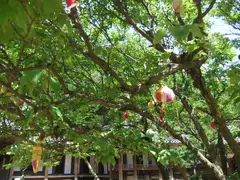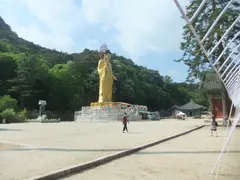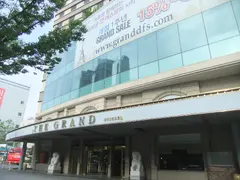
We checked out of the Aventree Hotel Seoul on a cloudless morning, a manager of the travel agents Korea Holiday Planners who had arranged my 7-day tour handed out pretty bags of various sweets including chocolates (which I passed on) and seaweed (which I munched during the long driving today on our way to Daegu). Our first stop was at the Korean Folk Village a collection of traditional buildings from different regions of Korea. Also visiting the Folk Village were all the school children in Korea making it rather crowded. There were zillions of coaches there, I almost gave up trying to find our coach when we left the Folk Museum. Our guide did his best to impart a lot of information (like only the nobles' houses could have colour, on the underfloor heating they had, on kimchi's preparation, on them hanging a cord for four weeks with chillies or charcoal (I think) on it to mark a boy or girl had been born, and to stop people entering a house). Too much information to remember but it was good to be told it.
We stopped at a very decent service station for lunch, a large food hall with 8 counters dispensing different dishes but one place where you ordered. I had a nice soup with rice dumplings in it (tteok-wang-mandu-guk), one returned the tray back to the counter it came from.

It was then on to Songnisan Park, a very large area where one can walk for hours up scenic mountains but we in our short time just saw the Beopjusa Buddhist temple with a very large gilded bronze Buddha standing tall. I was interested to see a price list for how much your donation would get you - so 70,000 won will mean a paper with your prayer on it will stays attached to one of the pretty Chinese lanterns hanging around the place, 500,000 won will mean you get prayed for by the monks for a thousand times. You could have your name on a roof tile which lasts 20-30 years before having to be replaced, or on one of the thousand small Buddhas in a temple beneath the giant one. The area we saw was very beautiful, and the guide related how the temples had to be rebuilt after the Japanese on one of their invasions destroyed them. He said the monks trained as warriors and fought which annoyed the Japanese.
A long drive onto Daegu, past more families of skyscrapers being built, past a few traditional style burial areas (less common now as the government owns most land, few have hillsides to put graves onto), past more rice paddies and greenhouses, past houses of brick but with traditional Chinese tiled roofs.

We arrived at the grand Grand Hotel, where I got given room 1783 and then got confused as the lift only went up to floor 12. It turned out Koreans like writing 7 in a strange way. The room is nice, though the curtains don't close properly, and it took me ages to work out the telephone controlled the lights. Another brave foray out into the darkness in search of ethnic food - this time the failure was ending up in a Japanese style eaterie called Don-Don where they cheered as customers came through the front curtain. The food was fine, though I was puzzled by Japanese style fare containing potatoes and string beans and carrots. The string beans I couldn't digest. At least it wasn't something from the many Western chains in Korea like Starbucks or Pizza Hut or Macdonalds or Dunkin Donuts. Pride was a little preserved!